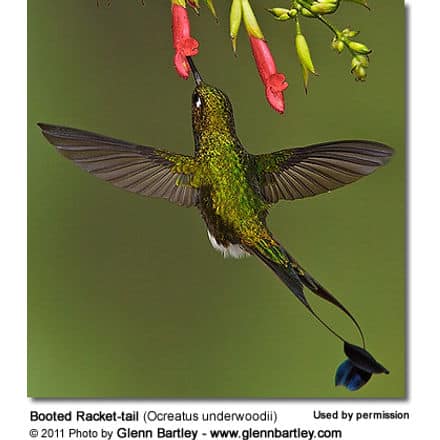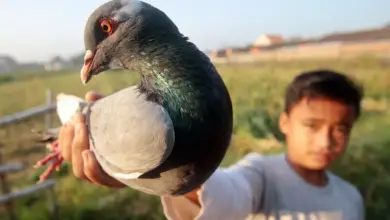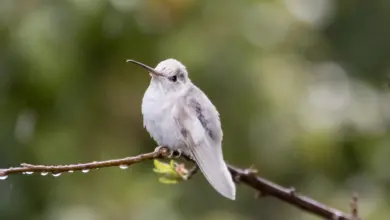Booted Racket-tail Hummingbirds
The Booted Racket-tail (Ocreatus underwoodii) – also known as Racket-tailed Puffleg – is a South American hummingbird.
Alternate (Global) Names
Spanish: Cola-de-raqueta Pierniblanco, Colibrí Cola de Hoja, Colibrí de Raquetas … French: Colibri à palettes, Haut-de-chausses à palettes, Haut-de-chausses à queue en palettes … Italian: Colibrì coda a racchetta di Underwood, Colibrì dalle racchette … Czech: Sylfa vlajková … Danish: Hvidkvastet Spatelhale … German: Flaggensylphe, Grünscheitel-Flaggensylphe … Finnish: Lippupyrstökolibri … Japanese: rakettohachidori … Dutch: Vlagstaartpluimbroekje, Vlagstaart-pluimbroekje … Norwegian: Vimpelkolibri … Polish: furczak … Russian: ????????? ?????????, ???????-?????????, ?????????? ???????-??????????? … Slovak: papuckavec chvostnatý … Swedish: Flaggsylf
Distribution / Range
They occur naturally in the Andean cordillera (mountains) of Bolivia, Colombia, Ecuador, Peru, and Venezuela.
In Venezuela, there is also a population on the northern coast.
Vocalizations
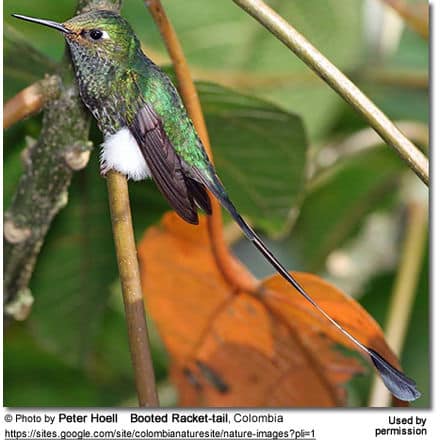
Subspecies and Distribution:
- Ocreatus underwoodii underwoodii (Lesson, 1832) – Nominate Race
- Found in the eastern Andes of Colombia.
- Ocreatus underwoodii polystictus (Todd, 1942)
- Found along the coastal mountains of northern Venezuela (Carabobo to Miranda).
- Ocreatus underwoodii discifer (Heine, 1863)
- Found in northwestern Venezuela (Zulia and Falcón to Táchira and W Barinas) and northeastern Colombia (Norte de Santander)
Description
The male Booted Racket-tail has geen upper parts and a long bluish tail. He has a snow-white dense feathering around the legs known as “leg puffs” (which are not always visible). These leg puffs have been described as resembling “woolly panties” or “little cotton balls” above the legs, These leg puffs are unique to the pufflegs.
Similar Species: The Marvellous Spatuletail has less green coloration on its plumage.
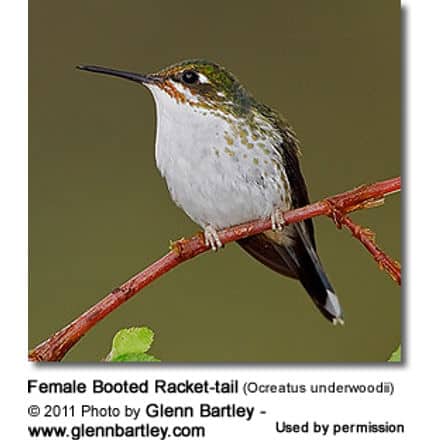
Nesting / Breeding
Hummingbirds are solitary in all aspects of life other than breeding, and the male’s only involvement in the reproductive process is the actual mating with the female.
They neither live nor migrate in flocks, and there is no pair bond for this species. Males court females by flying in a U-shaped pattern in front of them. He will separate from the female immediately after copulation.
One male may mate with several females. In all likelihood, the female will also mate with several males. The males do not participate in choosing the nest location, building the nest, or raising the chicks.
The female Booted Racket-tail is responsible for building the cup-shaped nest out of plant fibers woven together and green moss on the outside for camouflage in a protected location in a shrub, bush, or tree.
She lines the nest with soft plant fibers, animal hair, and feathers down, and strengthens the structure with spider webbing and other sticky material, giving it an elastic quality to allow it to stretch to double its size as the chicks grow and need more room. The nest is typically found on a low, skinny horizontal perch.
The average clutch consists of two white eggs, which she incubates alone, while the male defends his territory and the flowers he feeds on. The young are born blind, immobile, and without any down.
The female alone protects and feeds the chicks with regurgitated food (mostly partially digested insects since nectar is an insufficient source of protein for the growing chicks). The female pushes the food down the chicks’ throats with her long bill directly into their stomachs.
As is the case with other hummingbird species, the chicks are brooded only the first week or two and are left alone even on cooler nights after about 12 days – probably due to the small nest size. The chicks leave the nest when they are about 20 days old.
Diet / Feeding
The Booted Racket-tails primarily feed on nectar taken from a variety of brightly colored, scented small flowers of trees, herbs, shrubs, and epiphytes.
Hummingbird Resources
- Hummingbird Information
- Hummingbird Amazing Facts
- Attracting Hummingbirds to Your Garden
- Hummingbird Species
- Feeding Hummingbirds


